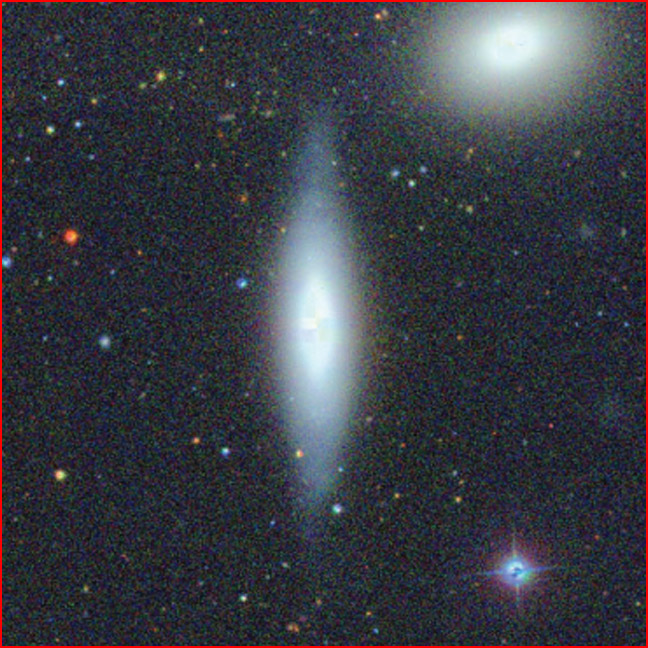
home •
about •
essential guide •
picture of the day •
thunderblogs •
news •
multimedia •
predictions •
products •
get involved •
contact
picture of the day archive subject index
NGC 4550, part of the Virgo Cluster of galaxies. Credit: University of Washington
Oct 09, 2007
NGC 4550: Galactic Bi-directionality
Counter-rotating stars and Newtonian dynamics provide galaxies with stable gravitational geometry, according to a recent publication. But is it electricity that determines galactic shapes and stability?Dr. Vera Rubin, the eminent astronomer and research scientist, was asked in the most recent issue of Physics Today to reflect on her discovery that NGC 4550 consists of stars that orbit in opposite directions within the galactic plane. Dr. Rubin writes:
"I took the first spectrum of NGC 4550 at the Palomar 200-inch telescope in 1989 with the double spectrograph...But from the first look at the spectrum, I had a vague sense that each stellar absorption line was double! After further study, I recognized that I had found a galaxy in which stars orbit, some clockwise, some counterclockwise, in the same disk...Our preliminary model suggested that shortly after the initial stellar disk of NGC 4550 formed, a substantial amount of captured gas settled to the plane...Yet we still do not understand its formation."
Dr. Rubin interpreted NGC 4550's "double lines" as a velocity-induced Doppler-shift. This has convinced her and many others in the astronomical community that the galactic arms of NGC 4550 (and a few other galaxies) contain stars that are moving in counter-rotation to one another. It is as if there are two discs of material overlying each other, one moving east and one moving west.
From the perspective of conventional astronomy that relies on gravitational theories of galaxy formation and rotation, the question of counter-rotating stars is a complete mystery. There is no known mechanism that will allow this phenomenon other than influence from an external force. As the theory states, it is through the impetus of spinning gasses created from the collapse of a gigantic cloud of hydrogen that stellar motion arises. In NGC 4550, the stars that appear to be moving in the other direction are thought to have formed from another cloud of gas that "settled" onto the pre-existing galaxy.
Since modern cosmogony demands that all structures we observe came about through the gravitational compression of a gas cloud, electricity is not considered when describing the unique formations and activity that are observed. Although no one knows how electricity flows through galaxies, it seems apparent that it does. In an electromagnetic field, induced by electric currents, particles with positive charges move in one direction and negative charges move in the other.
Plasmaspheres exist around all objects in space, whether they be comets or galaxies, and they exhibit longitudinal and latitudinal electron flux, regardless of the directionality. In those circumstances, Birkeland currents begin to rotate, pinching themselves down into filaments.
The stars are thought to appear as compressions in the ions flowing through the coaxial Birkeland filaments. The stars ignite as strings of pearls in complex new pinches. Multiple directions of current flow could mean that stars form with their orbits independent of the gravitational effects exerted by the galaxy. Their arc mode discharges could actually be shining along the filamentary sheets of Birkeland currents that energize the spiral arms of NGC 4550.
As electrical theorist, Wal Thornhill has written:
"Stars are formed efficiently in a cosmic plasma discharge known as a Z-pinch. A Z-pinch electromagnetically scavenges diffuse matter over a large volume of space with a force that diminishes directly with distance, not the much weaker square of the distance due to gravity. The Z-pinch forms a string of separate plasmoids, which become stars. It is the Z-pinch effect that generates the intense winds seen coming from star forming regions. As the discharge weakens and becomes unstable the stars are scattered like buckshot from their linear arrangement. The initial linear configuration could explain why some nearby stars tend to have similar axial alignments to that of the Sun."
Plasma physics as applied to cosmology and the evolution of galaxies is a relatively new paradigm. In previous Thunderbolts Picture of the Day articles, we have described how the theory of the Electric Universe may be applied to galactic morphology. In time, the theoretical science will gain confirmation through observation and new ideas will affect a shift in scientific reasoning.
By Stephen Smith
___________________________________________________________________________Please visit our Forum
The Electric Sky and The Electric Universe available now!

|
|

|
EXECUTIVE EDITORS:
David Talbott, Wallace Thornhill
MANAGING EDITORS:
Steve Smith, Mel Acheson
CONTRIBUTING EDITORS: Michael Armstrong, Dwardu Cardona,
Ev Cochrane,
C.J. Ransom, Don Scott, Rens van der Sluijs, Ian Tresman
WEBMASTER: Brian Talbott
Copyright 2007: thunderbolts.info
![]()
home •
thunderblogs •
forum •
picture of the day •
resources •
team •
updates •
contact us

